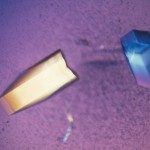Lien vers Pubmed [PMID] – 33137225
Lien DOI – 10.1002/chem.202004311
Chemistry 2021 Jan; 27(6): 2112-2123
In this work on the design and studies of luciferins related to the blue-hued coelenterazine, the synthesis of heterocyclic analogues susceptible to produce a photon, possibly at a different wavelength, is undertaken. Here, the synthesis of O-acetylated derivatives of imidazo[1,2-b]pyridazin-3(5 H)-one, imidazo[2,1-f][1,2,4]triazin-7(1 H)-one, imidazo[1,2-a]pyridin-3-ol, imidazo[1,2-a]quinoxalin-1(5 H)-one, benzo[f]imidazo[1,2-a]quinoxalin-3(11 H)-one, imidazo[1′,2′:1,6]pyrazino[2,3-c]quinolin-3(11 H)-one, and 5,11-dihydro-3 H-chromeno[4,3-e]imidazo[1,2-a]pyrazin-3-one is described thanks to extensive use of the Buchwald-Hartwig N-arylation reaction. The acidic hydrolysis of these derivatives then gave solutions of the corresponding luciferin analogues, which were studied. Not too unexpectedly, even if these were “dressed” with substituents found in actual substrates of the nanoKAZ/NanoLuc luciferase, no bioluminescence was observed with these compounds. However, in a phosphate buffer, all produced a light signal, by chemiluminescence, with extensive variations in their respective intensity and this could be increased by adding a quaternary ammonium salt in the buffer. This aspect was actually instrumental to determine the emission spectra of many of these luciferin analogues.






